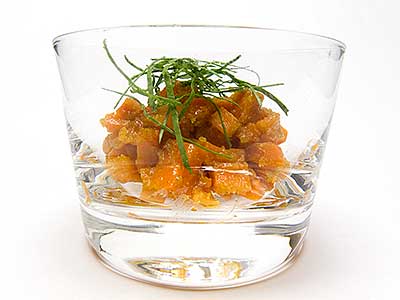May 13, 2013
Amuse-Bouche

carottes confit au cumin
(carrot salad)
The chef motioned me over to the largest plat à sauter I had ever seen. It was made of aluminum and appeared to be about a meter (3 ft) in diameter and 15 cm (6 in) high. It had two handles, but I wondered if it could be moved when it was full of fat, as it was now. Besides the fat, there was a jumble of duck legs peacefully bubbling away. The chef motioned for me to turn the legs in the fat. I didn’t see any tongs around. He just laughed, and plunged his hand into the hot fat. I quickly learned that although the duck legs were gurgling away, the fat wasn’t too hot if you didn’t leave your hand in too long.
I soon learned that the chef was very slowly cooking the duck legs in a process called confit. The slow cooking would break down the tough connective tissue in the legs. They would be cooled overnight in the fat, and then packed in ceramic crocks with the same duck fat filling all the spaces and protecting the legs from the air. This was an old method of cooking and preserving the legs for use later in the year.
This was the end of January, beginning of February in 1997. It was my first extended visit to a French restaurant kitchen. I was just starting my journey into the wonderment of French cooking.
Since my first introduction to confit sixteen years ago, I’ve encountered the term many times in many ways. I later learned that pork could be cooked and preserved the same way. Then I noticed the term was showing up on restaurant menus whenever an item was cooked over low heat for a long time. Later I noticed it showing up in the French cooking magazines I was buying. When I opened a little book in the bookstore last summer in France and found a recipe on page 12 titled carottes confit au cumin, I wasn’t surprised, even though carrots were far removed from duck legs and no preserving was intended. The recipe looked like it may work as an amuse-bouche, although not as it was written. After paying the 5 € ($7.01 at the time), I was the proud owner of Divines verrines by Maya Barakat-Nuq. The book is a slim collection of 36 recipes for dishes served in glasses, which in French is verrines.
The recipe in the book made a huge portion, 200 g (7-1⁄2 oz) of carrots per guest. A bit much even for a first course. It also had a high number of ingredients, many which seemed superfluous to me. So here is my simplification. It makes enough for 4 amuse-bouche servings.
100 g (3-1⁄2 oz)
carrots, peeled, 4-mm (5⁄32-in) dice
1 whole clove
garlic, peeled
1⁄4 t
ground cumin
1⁄4 t
ground coriander
1 t
granulated sugar
10 g
unsalted butter
fine salt
water
extra-virgin olive oil
Melfor honey-herb vinegar
fine salt and freshly ground black pepper, to taste
4 large leaves
flat-leaf parsley, very finely sliced
1. Place the carrots, garlic, cumin, coriander, sugar, butter, and salt in a saucepan. Add water to float but not cover carrots. Bring to a boil. Boil until the saucepan is dry and the carrots start to brown.
2. Transfer the cooked carrots to a bowl. Add a little olive oil and vinegar, and gently mix. Sprinkle with some salt and pepper. Mix again. Set aside to cool.
3. To serve, discard the garlic clove and divide the carrots between serving glasses. Arrange a little parsley on top of each serving.
Note: In some ways, this is an ideal amuse-bouche. It can be prepared far in advance and plated just before serving. Unlike other herbs, the parsley, if dry will hold well after slicing.
Note: I think this would also be great with parsnips instead of the carrots.
© 2013 Peter Hertzmann. All rights reserved.
